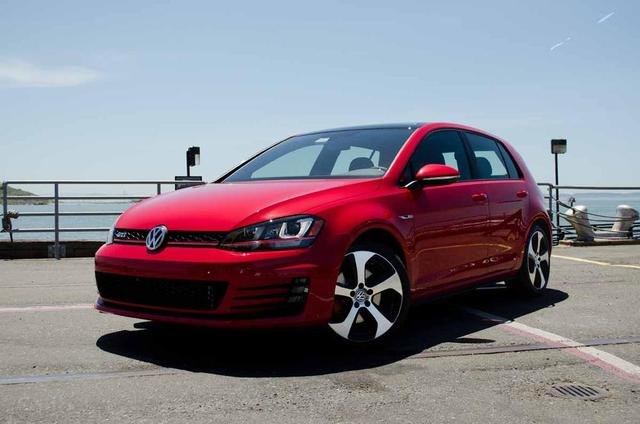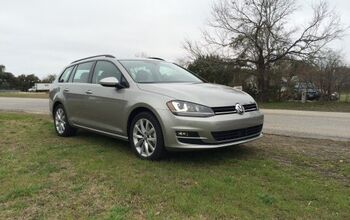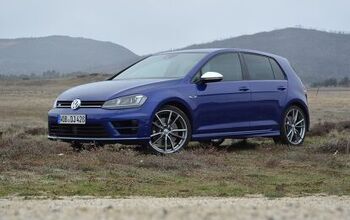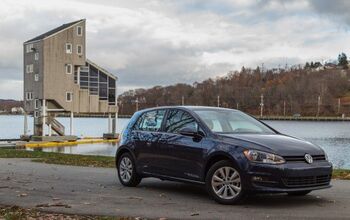Capsule Review: 2015 Volkswagen Golf GTI
There I was, all ready to do something that no automotive journalist ever does: purchase a brand new performance car. I was days away from going down to the local Ford dealer and signing on the dotted line for a brand new Ford Fiesta ST. I had it all picked out: an ST3 model, with the Recaros, grey wheels and Performance Blue paint. And then I got a phone call from Volkswagen, offering me the chance to drive the brand-new, MK7 GTI.
For those of you still reading the buff books, the MK7 GTI has been out for the better part of a year – and every keen TTAC reader knows that this is the first GTI to be built off of VW’s MQB modular architecture. But what does it mean for the enthusiast who doesn’t live and breathe the ins-and-outs of modular architectures?
Well, quite a bit. The MK7 is longer, wider, more spacious inside, while packing more power and less weight. Length is up by 2.1 inches, while width is up by half an inch. Notably, the GTI loses 1.1 inches in overall height, while the front wheels have been moved forward by nearly two inches (thanks to the MQB chassis placement of the pedal box), which adds up to the much more pleasing “lower, longer, wider” look.
The overall effect is that of a substantial car. From the outside, the GTI still looks like it takes up the expected footprint of a C-segment car. Inside, the cabin looks nothing short of huge. The panoramic sunroof and generously bolstered seats give it an airy feel, while the uncomplicated center console feels like it belongs in something with four rings. The rear seats contain enough room for two full-size male adults, though three abreast might be a stretch. It’s better than a number of CUVs that I’ve recently come across, and would be more than adequate for the sort of “bro-trips” that many buyers of this car will undertake. Like most auto reviewers, I adore the tartan cloth and would skip the leather upholstery.
The added size appears to have no negative consequences for the GTI’s performance. Dynamically, the GTI has but one fault. The gas and brake pedals are spaced too far apart to properly execute a heel-toe downshift. Everything else you’ve read about the car is true: it is utterly brilliant, and possibly the best all-round performance car on the market.
The newest generation of Volkswagen two-point-oh-tee motor delivers peak twist at just 1,500 rpm, pulling all the way up to 4,500 rpm. That means all 258 lb-ft is easily accessible in the meat of the power band, right where you’d be most inclined to use it. Torque-steer manages to be mercifully contained, and describing the acceleration as “brisk” doesn’t quite do this car justice.
An optional Performance Pack adds another 10 horsepower, bigger brakes and a limited-slip differential. Does the GTI need it? I’m not sure. The example we tested did not have it, and I never wished for a second that it did. The brakes are strong and progressive, the handling beautifully composed with crisp, quick steering and the kind of sharp turn-in that you wouldn’t normally expect on a front-wheel drive car.
This performance is also fully accessible to the average driver on something as banal as a highway on-ramp, and you can tap into it while you’re averaging 26 mpg in spirited driving. Even with the low-profile tires and sharp handing, the ride is never punishing. If the light clutch and precise 6-speed manual gearbox are too arduous for your daily commute, there’s a dual-clutch gearbox available as well. What could possibly be wrong with a car that can truly lay claim to being the ultimate performance daily driver?
Well, as Jack said
Imagine that the GTI was slow-roasted until all the joy dripped out of it. Then imagine that all the joy that dripped out was caught in a drip pan. Then imagine that the drip pan was emptied into the Fiesta ST.
When I was 17 years old, my father bought a MKV Jetta 2.0T, and I, entitled little brat that I was, scoffed at the notion that a powerful, front-wheel drive car could be any fun. After all, video games and endless forum flame wars had taught me, so it had to be true. As it turned out, I adored that car, and I adore the MKVII, which is faster, lighter sharper and more refined than the MKV, with its laggy motor and first-generation DSG, ever was. But even though I’m less entitled and (slightly) more mature, I still want the raucous, slightly unhinged brand of front-drive fun that the Fiesta ST offers, even at the expense of the GTI’s substantial rear seat and cargo area. For everyone else that’s gotten that puerile recklessness out of their system, the GTI is the one you want.
N.B. Our photography car has a DSG gearbox, but is otherwise identical to our tester. Thanks to AutoGuide.com for the photograpy.
More by Derek Kreindler
Latest Car Reviews
Read moreLatest Product Reviews
Read moreRecent Comments
- Jkross22 Their bet to just buy an existing platform from GM rather than build it from the ground up seems like a smart move. Building an infrastructure for EVs at this point doesn't seem like a wise choice. Perhaps they'll slow walk the development hoping that the tides change over the next 5 years. They'll probably need a longer time horizon than that.
- Lou_BC Hard pass
- TheEndlessEnigma These cars were bought and hooned. This is a bomb waiting to go off in an owner's driveway.
- Kwik_Shift_Pro4X Thankfully I don't have to deal with GDI issues in my Frontier. These cleaners should do well for me if I win.
- Theflyersfan Serious answer time...Honda used to stand for excellence in auto engineering. Their first main claim to fame was the CVCC (we don't need a catalytic converter!) engine and it sent from there. Their suspensions, their VTEC engines, slick manual transmissions, even a stowing minivan seat, all theirs. But I think they've been coasting a bit lately. Yes, the Civic Type-R has a powerful small engine, but the Honda of old would have found a way to get more revs out of it and make it feel like an i-VTEC engine of old instead of any old turbo engine that can be found in a multitude of performance small cars. Their 1.5L turbo-4...well...have they ever figured out the oil dilution problems? Very un-Honda-like. Paint issues that still linger. Cheaper feeling interior trim. All things that fly in the face of what Honda once was. The only thing that they seem to have kept have been the sales staff that treat you with utter contempt for daring to walk into their inner sanctum and wanting a deal on something that isn't a bare-bones CR-V. So Honda, beat the rest of your Japanese and Korean rivals, and plug-in hybridize everything. If you want a relatively (in an engineering way) easy way to get ahead of the curve, raise the CAFE score, and have a major point to advertise, and be able to sell to those who can't plug in easily, sell them on something that will get, for example, 35% better mileage, plug in when you get a chance, and drives like a Honda. Bring back some of the engineering skills that Honda once stood for. And then start introducing a portfolio of EVs once people are more comfortable with the idea of plugging in. People seeing that they can easily use an EV for their daily errands with the gas engine never starting will eventually sell them on a future EV because that range anxiety will be lessened. The all EV leap is still a bridge too far, especially as recent sales numbers have shown. Baby steps. That's how you win people over.












































Comments
Join the conversation
Drove one of these in the past week...for my preference it's a gem. Fun when you want it to be, completely composed just cruising quietly. Obviously they could have made it more wild and fun, but it would have sacrificed the composed side of the car. As it is it strikes a beautiful balance. A couple of annoyances that would make me hesitate: -The artificial engine noise in "sport" mode is comical at best. I would need to immediately disable this "feature" to drive it daily. -The hatch space is a little smaller than I was hoping for. There's more window on this car than a lot of modern hatches (especially the back), but I think it may sacrifice some of the clever ways manufacturers are getting more trunk space out of their small designs. The Mazda3, for example, has a very small and slanted rear hatch that is bad for visibility but great for the floor length of the rear compartment. It's almost exactly the same size as my current car, a Protege5. -I've never owned a german car. The reliability horror stories are seemingly endless. I'll probably wait a year on these at least to see how the initial models shake out, but it they get even average reliability I'll be sorely tempted to buy one.
I stumbled on this forum while checking out the new GTI, and enjoyed the comments as much as the review, found resonance in my own thinking - a respect for Honda, a mistrust for VW I didn't know I had. But I do have evidence for both opinions. I've owned some nice cars, and you'd be surprised at the one I keep and enjoy daily - a 2011 Milano Red MT Honda Fit Sport, upgraded with black powder coated 17x7 Kosei Racing wheels and 215-40 Kumho ECSTA LE tires, the only customizing items that affect performance. Like at least one other reviewer above, I also have a 2004 Honda S2000 all fixed up original with new Dunlop Direzza S2 tires. What a great enthusiast's car. I bought a new 2014 BMW 320i with the Sport package, but after a year only had 1,000 miles on it, so I sold it for about a $10,000 loss (should have specified MT), just to illustrate that I like my Fit for itself. I take it on our nearby East County twisty two lane mountain roads in company with friends with new powerful cars - A Ferrari F430, an R8, a 911S4, a 2008 Porsche Turbo, and the like. Believe it or not, except for problems passing other vehicles due to its meager 117 horsepower, I do just fine in fast curves with the Fit. (I bought the S2000 after I sold the BMW.) I've owned several Hondas bought new: 2004 Civic EX, 2007 Accord SE, a 2011 Accord SE, the 2011 Fit, and the 2004 AP2 silver/black leather S2000. Obviously, I didn't keep any long enough to test longevity, but my son kept a 2003 Civic ten years, outdoors, and all it needed was a little work with the headliner. (Now he has a Tiguan he likes a lot.) He's the one who got me started with Honda, buying his 2003 that led me to buy the 2004. As to VWs, aside from several new Beetles that I loved, I owned a new original version of the Scirocco that I also loved, but never could get the back seat to fold properly. (With what I now know about wheel and tire sizes and specs, I'd love it today with wheels and tires of my choosing.) Aside from that seat problem, none of that VW experience was negative. But, my neighbor, who has the F430 and the Porsche Turbo, also has a Jetta station wagon he bought new two or three years ago, and parks on the street. He's often away, and I drive his Jetta weekly to keep the battery up. (In fact, he's the reason I checked out the new GTI, because he's planning to sell the Porsche and trade the Jetta for a new GTI.) When I drive his Jetta, the wheels positively grind from crap collected in the wheels. The car just doesn't feel good, including jerky automatic shifts, but to be fair we live near the ocean. On the other hand, the son of another friend bought the previous version of the GTI, and is an enthusiastic fan. He can't wait to own the new one. Enough. No one will read my drivel, but I do love cars. And motorcycles, but that's another story.